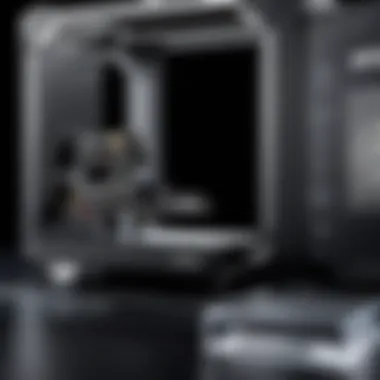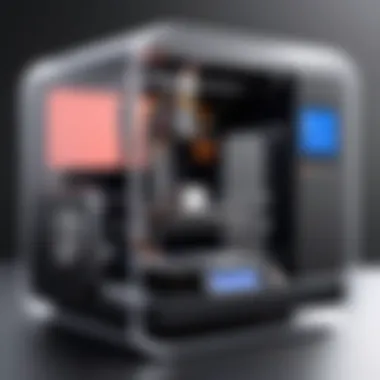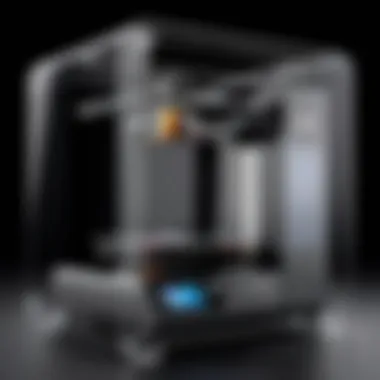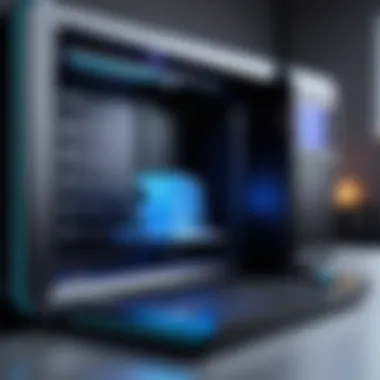Top Nylon Filaments for 3D Printing: An In-Depth Review


Intro
The landscape of 3D printing has experienced a significant evolution over the past few years, especially concerning materials used. Among them, nylon filament has gained substantial traction due to its strength, flexibility, and resilience. As new and varied applications for 3D printing continue to emerge, understanding the nuances of different types of nylon filaments becomes essential for enthusiasts and professionals alike.
This article aims to dissect the characteristics and applications of various nylon filaments suited for 3D printing. It will guide readers through the distinct properties of nylon, highlighting why it is increasingly favored in the 3D printing community. Furthermore, the article offers a careful evaluation of several brands, assisting potential buyers in making informed choices based on performance, cost-effectiveness, and the specific needs of their projects.
Let’s dive deeper into the world of nylon filament for 3D printing, starting with a product overview.
Understanding Nylon in 3D Printing
Nylon plays a pivotal role in the realm of 3D printing, noted for its versatility and performance capabilities. Understanding nylon is essential for crafting durable and functional prints, especially in applications demanding reliability. The filament's properties make it desirable for both hobbyists and professionals. Its adoption is increasing, and grasping its unique characteristics will aid users in making informed decisions.
Definition of Nylon
Nylon refers to a class of synthetic polymers known as polyamides. These materials are created through a process called polymerization, which joins smaller molecules into long, repetitive chains. Commonly used in textiles, nylons are also prevalent in 3D printing due to their favorable mechanical properties. In the context of 3D printing, nylon is favored for its robustness and flexibility, setting it apart from other materials.
Properties of Nylon Filament
Strength and Durability
Nylon is known for its exceptional strength and durability. It exhibits a higher tensile strength compared to many other commonly used filaments, allowing it to withstand significant stress without snapping. This is particularly beneficial for parts that will experience mechanical loads or impact. Its durability extends the lifespan of printed objects, making it a popular choice for functional prototypes and end-use parts.
Flexibility
Flexibility is another noteworthy property of nylon. Unlike more rigid materials such as PLA, nylon can bend without breaking. This characteristic allows for the creation of intricate designs that require a degree of elasticity. The balance of flexibility and strength reduces the risk of fractures during use. However, it is important to note that over-flexibility can lead to deformation if not managed properly in design.
Temperature Resistance
Temperature resistance is a key feature of nylon. It can endure higher temperatures than some filaments, which makes it suitable for applications where it may be exposed to heat. This characteristic enhances the filament's usability in different environments. Nonetheless, while it can handle higher temperatures, users should still examine specific temperature ratings to avoid any failures in long-term exposure.
Comparison with Other Filaments
PLA vs. Nylon
When comparing PLA and nylon, several differences emerge. PLA is easy to print and biodegradable, making it user-friendly, especially for beginners. However, it lacks the strength and flexibility found in nylon. Nylon, on the other hand, provides high performance, making it more suitable for complex engineering projects. The trade-off is that nylon can be more challenging to print, often requiring precise settings and conditions.
ABS vs. Nylon
ABS typically provides good strength and impact resistance, but it is not as flexible as nylon. Users looking for parts that require a combination of strength and flexibility tend to prefer nylon. ABS can also emit fumes during printing, requiring better ventilation during the process. Conversely, nylon is known to be less toxic and safer to work with in enclosed spaces.
PETG vs. Nylon
PETG is another popular choice in 3D printing, known for its clarity and good strength. While PETG has its merits, nylon excels in flexibility and abrasion resistance. Users requiring very durable parts for functional applications often choose nylon over PETG. Each material has a specific category of use, and understanding these distinctions can significantly influence the choice of filament.
Advantages of Using Nylon Filament
Nylon filament is increasingly favored in the 3D printing community for its versatile properties and performance abilities. Understanding the advantages of using nylon filament is essential for those looking to enhance their 3D printing projects. This section discusses the key benefits, focusing on mechanical properties, chemical resistance, and applications in various industries.
Mechanical Properties
Nylon is known for its robust mechanical properties. It boasts high tensile strength, which means it can withstand significant stress before breaking. This feature is crucial for applications requiring durable prototypes or functional parts. Unlike other common filaments, nylon can also absorb impact well. This makes it suitable for producing items that may endure mechanical shocks, such as gears or brackets.
Moreover, nylon exhibits excellent flexibility, allowing it to bend without permanently deforming. This characteristic adds to its usefulness in designs where a degree of deformation is expected.
It is notable that nylon's properties can differ based on its specific type. Nylon 6, for example, is renowned for its enhanced toughness, while Nylon 12 offers a lower moisture absorption rate. Therefore, understanding the variations in mechanical properties is vital for selecting the right type for specific applications.
Chemical Resistance
Chemical resistance is another significant advantage of nylon filaments. Nylon can tolerate exposure to many different substances without degrading. This is beneficial for parts that will be used in harsh environments or require cleaning agents for maintenance. Being chemically resistant means that the printed parts maintain their integrity longer, providing reliability crucial for mechanical components in industrial settings.


For instance, nylon is often used in manufacturing components for the automotive industry, where parts must resist oils, fuels, and other chemicals. This resilience translates to less frequent replacements and, ultimately, cost savings over time.
Applications in Industry
The adaptability of nylon filament finds it applications across various sectors. In prototyping, nylon's mechanical strength allows for the creation of functional models that simulate actual use conditions. This capability is essential for testing designs before full-scale production.
In the automotive industry, nylon is utilized in producing strong, lightweight components like dashboards and interior fittings. Similarly, in aerospace, parts made from nylon must meet stringent weight and durability criteria.
Moreover, the growing popularity of nylon in the medical field cannot be overlooked. Its biocompatibility and strength allow for the development of custom medical devices and tools. As industries continue to evolve, the relevance of nylon filament will likely grow.
Key Insight: The advantages of nylon filament extend beyond mere strength, influencing numerous sectors by improving design possibilities and enhancing product reliability.
Types of Nylon Filaments Available
Understanding the different types of nylon filaments is essential for selecting the right material for specific 3D printing needs. Each filament type has unique properties that can significantly impact the quality and functionality of the finished product. Knowing these differences can guide users in making informed decisions that suit their project requirements.
Nylon
Nylon 6 is one of the most commonly used nylon filaments in 3D printing. It is well-known for its excellent mechanical properties, offering high strength and impact resistance. This filament experiences minimal deformation under stress, which makes it a popular choice for functional prototypes and end-use parts.
The processing of Nylon 6 yields a semi-crystalline structure, allowing it to withstand higher temperatures compared to many other materials. This feature makes it suitable for applications where thermal stability is crucial. Users often report favorable printing results with Nylon 6, but care should be taken to monitor moisture levels, as it is prone to absorbing humidity.
In summary, because of its strong characteristics, Nylon 6 is often regarded as a workhorse in various industrial applications.
Nylon
Nylon 12 presents an alternative for those seeking a more flexible and lightweight option. This filament offers lower moisture absorption than Nylon 6, which makes it suitable for applications where dimensional stability is vital. The reduced moisture absorption leads to lower risks of warping during printing, allowing for easier handling.
Nylon 12 also boasts a smooth finish and enhanced surface quality, making it appealing for aesthetic items as well as functional prototypes. The elasticity of this material enables designs requiring flexing without breaking. However, the cost of Nylon 12 can be higher than other filament options, and considerations should include the specific performance attributes needed for the application.
Polyamide vs. Nylon
When discussing nylon filaments, it is common to encounter the term polyamide. Polyamide is a family of polymers that includes various types of nylon, with Nylon 6 and Nylon 12 being two of the most recognized subtypes. The primary distinction lies in their molecular structure and properties.
Polyamides can offer broader functionalities. For instance, while Nylon 6 is recognized for strength, other polyamides may be engineered for soft touch or food contact compliance. Therefore, understanding the specific type of polyamide used can vastly change the functionality of the printed items. In short, recognizing that "nylon" typically refers to a subset of polyamides will aid in selecting the right material for any task.
Key Considerations for Choosing Nylon Filament
Choosing the right nylon filament involves multiple factors. These factors can significantly influence the quality, performance, and satisfaction of your 3D printing projects. Understanding such key considerations is essential for both novice and experienced users when deciding on which nylon filament to utilize.
Compatibility with 3D Printers
Not all 3D printers are designed to work with every type of filament. Therefore, compatibility is a crucial element.
- Printer Specifications: Check your printer’s specifications to understand the types of nylon it supports. Some printers may require an all-metal hotend for higher temperature filaments.
- Extrusion Temperature: Nylon generally requires higher extrusion temperatures. Most nylon filaments perform optimally between 240°C to 260°C, while some varieties may need even more heat.
- Build Plate: Temperature stability of the build plate should also be considered. A heated bed can help in ensuring better adhesion and reducing warping.
Ensuring compatibility can prevent printing issues down the line, reducing frustration and wasted material.
Cost and Availability
The cost of nylon filaments can vary significantly based on type and brand. Understanding your budget can help narrow down choices effectively.
- Budget Brands vs. Premium Options: While premium options may offer advanced features or improved quality, budget brands often provide decent performance for hobbyists. Each user must assess their needs and choose accordingly.
- Availability: Research where to purchase the filament. Some filaments may not be available locally, while others can be found in bulk online. Availability can affect lead times for your project indeed.
- Shipping Costs: Keep an eye on shipping fees, as they may inflate costs considerably. Always consider the total price when making comparisons.
Storage and Moisture Sensitivity
Nylon is known to absorb moisture from the air, which can deteriorate its properties. Proper storage is vital to maintain the filament’s performance and longevity.
- Dry Conditions: Store nylon filaments in dry environments. Use silica gel packets in your storage container to reduce moisture absorption.
- Sealed Packaging: Consider purchasing nylon filament that comes in vacuum-sealed packaging. This helps in ensuring the filament remains dry until you are ready to use it.
- Re-Drying Filament: If you suspect your filament has absorbed moisture, it can often be dried in an oven at low temperatures. This can restore some of its original performance characteristics.
Proper storage and awareness of moisture sensitivity can preserve the material quality and improve print results.


Reviewing Top Nylon Filaments
In the realm of 3D printing, selecting the right filament is crucial for achieving optimal results. This section focuses on reviewing several top nylon filaments available on the market. Understanding the unique characteristics and performance of these products can significantly influence the outcome of your printing projects. By examining notable brands like NylonX by MatterHackers, Taulman 3D, eSUN, and ColorFabb, we highlight their features, user feedback, and price ranges. This provides practical insights that can guide users towards making informed choices based on their specific needs and preferences.
NylonX by MatterHackers
Features
NylonX by MatterHackers is recognized for its robust characteristics. One key aspect of NylonX is its reinforced structure, which enhances overall strength. It contains carbon fiber, adding to its durability while still allowing for flexibility. Users often prefer this filament for projects that require better impact resistance. Compared to standard nylon, NylonX is a more reliable choice for demanding applications.
User Reviews
User feedback on NylonX is largely positive. Many users appreciate its ease of use, noting that it prints smoothly with minimal stringing or warping. People often mention that its adhesion to the build plate is superior. However, a few users have pointed out that it can be more challenging to print with compared to other materials, especially for those not familiar with nylon filaments.
Price Range
The price of NylonX is typically above the average for standard nylon filaments but reflects its advanced properties. It is positioned within the mid to high price range, which can be justified by its performance advantages. While some may hesitate due to the increased cost, many find the investment worthwhile for the quality it provides.
Taulman 3D Nylon Filament
Features
Taulman 3D offers a variety of nylon filaments, with notable features that attract many users. One of its highlights is the diverse range of formulations available, allowing users to select based on specific needs. The filament is known for its excellent layer adhesion, contributing to the overall strength of printed parts. This is especially beneficial when creating functional parts that need to withstand mechanical stresses.
User Reviews
Reviews for Taulman 3D filament indicate a strong user base that values its performance. Many users express satisfaction with its print quality and versatility. However, some have noted the necessity for precise temperature settings, as getting them wrong can result in subpar prints. Overall, it remains a favored choice among experienced 3D printing enthusiasts.
Price Range
Taulman 3D filaments can be found in a competitive price range. While they may not be the cheapest option available, users often feel that the quality justifies the cost. Therefore, the pricing is deemed reasonable, especially for those who prioritize performance and reliability in their printing projects.
eSUN Nylon Filament
Features
eSUN's nylon filament distinguishes itself with quality and versatility. A notable feature is its excellent moisture resistance, making it easier to store and handle. Users appreciate its low shrinkage rate, which minimizes warping during printing. This makes it a sound choice for beginners and experts alike who seek reliable results without extensive trial and error.
User Reviews
User feedback for eSUN nylon filaments is generally favorable. Many users highlight its affordability alongside quality. Beginners often mention that it is easier to work with compared to other nylon options. However, some experienced users point out that while it's a solid choice, it may not offer the same level of strength as higher-end variants.
Price Range
eSUN nylon filaments are recognized for being budget-friendly. Their pricing is generally more accessible compared to some competitors. This affordability makes eSUN an attractive option for those who want to experiment with nylon without committing to higher-cost products.
ColorFabb Nylon Filament
Features
ColorFabb is known for producing high-quality nylon filaments that deliver impressive performance. A standout aspect of ColorFabb's offerings is its filament blend, which often includes additives to enhance strength and functionality. The brands’ products are engineered for ease of printing, reducing the common issues associated with nylon filaments.
User Reviews
The user reviews for ColorFabb nylon filaments are predominantly positive. Many users appreciate the durable final prints and ease of use. The consistency of the filament’s diameter is often praised, which contributes to better print results. However, some users have commented on the need for precise calibration for optimal results, particularly when handling different filament colors.
Price Range
ColorFabb’s pricing is generally in the mid-range. While it is not the cheapest option, the quality it provides is often considered worth the investment. Buyers may find that the cost-effectiveness is reflected in the reliability and performance during printing.


Application Areas for Nylon 3D Printing
Understanding the application areas of nylon in 3D printing is crucial for manufacturers and engineers. Nylon is valued for its excellent mechanical properties and versatility. Users across different industries are increasingly adopting nylon for various applications. This section explores key areas where nylon filament plays a vital role. Each application signifies how nylon adapts to specific needs, ensuring its position as a preferred material in modern printing technologies.
Prototyping
Prototyping represents one of the most significant applications for nylon filaments. Engineers benefit greatly from its durability and strength during the testing phase. Nylon can withstand stress and strain, which makes it suitable for creating functional prototypes that closely mimic end products. The ability to create prototypes that engage in actual testing without the risk of immediate failure leads to more reliable assessments of design and functionality.
Moreover, the flexibility of nylon enables it to absorb impact without breaking, making it an attractive option for industries aiming for high-performance prototypes.
Automotive Industry
In the automotive sector, nylon filaments are essential for producing components that require high strength and heat resistance. Various parts like brackets, housings, and clips can be efficiently manufactured using nylon. Additionally, the material is known for its chemical resistance, making it ideal for parts exposed to oils and fuels.
Nylon's lightweight nature contributes to overall vehicle efficiency by reducing weight. This is critical for manufacturers looking to improve fuel consumption and performance metrics. Furthermore, the ability to produce custom parts on demand allows faster production cycles and a shorter time-to-market.
Aerospace Applications
The aerospace industry is one that heavily demands materials that ensure safety, durability, and performance. Nylon filaments are utilized here for various applications, including structural components and interior parts. They can meet stringent weight and strength regulations. The material's resistance to abrasion and its capacity to remain stable in a wide range of temperatures add to its appeal.
Additionally, the possibility of creating complex shapes via 3D printing reduces material waste and production time. This plays a pivotal role in a field where precision and efficiency are paramount. By incorporating nylon into their production processes, aerospace companies can streamline their workflows and improve their component reliability.
Challenges in Using Nylon Filaments
Using nylon in 3D printing comes with a set of unique challenges that users must consider. Understanding these challenges is crucial for making informed decisions about printing with nylon filament. This part of the article focuses on important aspects related to warping, print settings adjustment, and post-processing needs. Each of these factors plays a significant role in the successful use of nylon in various projects.
Warping Issues
One of the most prevalent concerns when using nylon filament is warping. Warping occurs when the printed material cools unevenly, leading to curled edges and a distorted shape. This problem is particularly common with nylon due to its high thermal expansion properties. As the filament cools, it can pull away from the print bed, which can compromise the integrity of the print. To mitigate this, users can utilize a heated print bed. A temperature range of 70 to 100 degrees Celsius is often recommended to keep the nylon warm during printing.
Additionally, applying an adhesive like glue stick or hairspray can help ensure better adhesion to the print surface. The choice of print surface is also vital; a PEI or glass bed can provide better results compared to other materials. Preheating the environment can also decrease the risk of warping, just as ensuring proper airflow around the print can help maintain consistent temperatures.
Print Settings Adjustment
Print settings are fundamental when it comes to successfully using nylon in 3D printing. Users often need to adjust parameters such as nozzle temperature, print speed, and layer height. A typical nozzle temperature for nylon ranges between 240 and 260 degrees Celsius. Higher temperatures help with filament flow and adhesion between layers, reducing the chances of print failure.
Moreover, it’s crucial to slow down print speed. This means that beginners should consider starting with lower speeds. A speed of around 30 to 40 mm/s can be effective for better layer adhesion. Furthermore, implementing thicker layer heights can enhance the stability of prints and reduce the likelihood of warping or delamination.
Post-Processing Needs
Post-processing is often essential after printing with nylon filaments. While nylon produces prints that can be exceptionally strong and durable, the finish may not meet user requirements right out of the printer. Sanding, painting, or sealing with specific coatings can improve the aesthetic appeal and performance of the final product.
Sanding helps remove imperfections, while specialized coatings can enhance chemical resistance and overall durability. In some cases, a treatment such as vapor smoothing can be valuable; it uses chemicals to slightly melt the surface of the print, offering a smoother finish.
"Understanding the challenges associated with nylon filaments is essential for achieving high-quality prints. Effective strategies can lead to better performance and more satisfying results."
Meeting these challenges involves careful planning and application of best practices. Adequate preparation, knowledge of the materials, and appropriate print settings will contribute significantly to successful outcomes in 3D printing with nylon. "Nylon in 3D printing often pushes the boundaries of what is possible but requires careful handling to achieve the best results."
Future of Nylon in 3D Printing
The future of nylon in 3D printing is pivotal in shaping the materials landscape. As the demand for more durable and versatile materials grows, nylon is establishing itself as a leader due to its unique properties. Understanding this future trajectory is essential for all stakeholders, from hobbyists to industry professionals. With advancements in formulations and processing techniques, we can expect nylon to further penetrate various sectors such as automotive and aerospace.
Advancements in Material Science
Recent developments in material science have significantly enhanced nylon's capabilities for 3D printing. New blends and formulations have been introduced, such as nylon reinforced with carbon fiber. These formulations provide increased strength while maintaining lightness. Researchers are continually exploring ways to reduce moisture absorption, which has historically hampered nylon's effectiveness.
Additionally, bio-based nylons and recyclable options are emerging. This shift aligns with the global trend towards sustainability in manufacturing. As consumers demand eco-friendly solutions, the material science surrounding nylon is responding positively.
One notable advancement is the ability to modify nylon properties at the molecular level, leading to improved inter-layer adhesion and reduced warping during printing. Such enhancements can facilitate smoother operations across various 3D printers without compromising quality. Through these advancements, nylon is becoming even more suitable for high-performance applications.
Trends in 3D Printing Technology
Advancements in 3D printing technologies also influence the future of nylon. The introduction of high-temperature nozzles and improved extrusion systems allows for better processing of nylon filaments. These technologies can handle varied print speeds and temperatures, optimizing the printing process.
Moreover, the rise of hybrid printing technologies, which combine different methods, is notable. For instance, mixing FDM (Fused Deposition Modeling) with SLS (Selective Laser Sintering) can allow nylon to be used in more versatile ways, resulting in products that demonstrate a blend of properties from both techniques.
Emerging trends such as on-demand manufacturing are also shaping the nylon market. Businesses can produce parts as required, minimizing waste and storage needs. This method appeals particularly to industries where custom parts are necessary.







